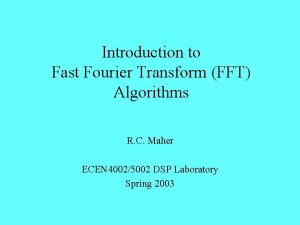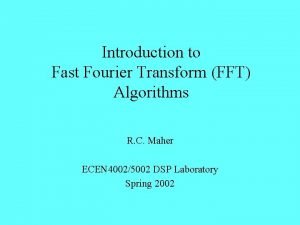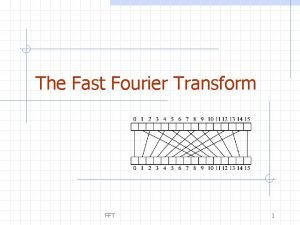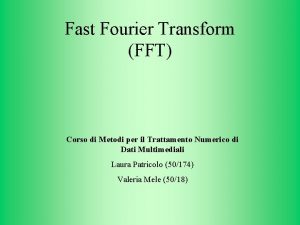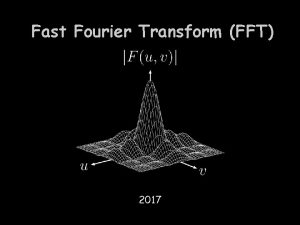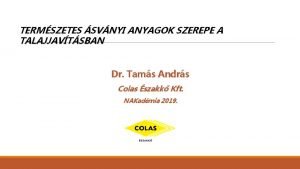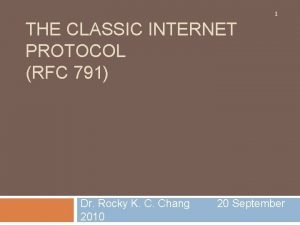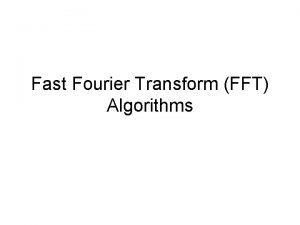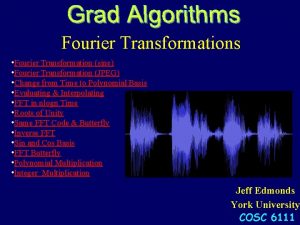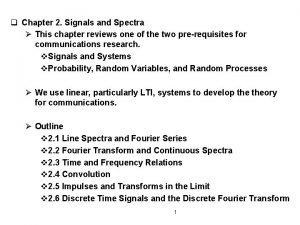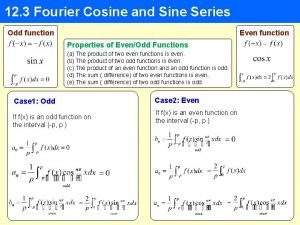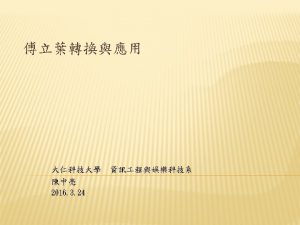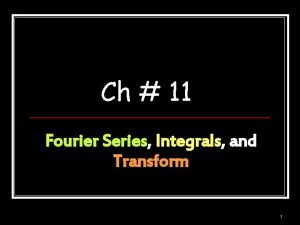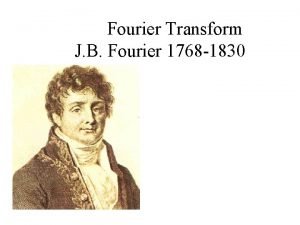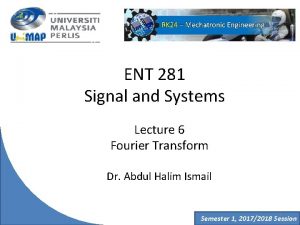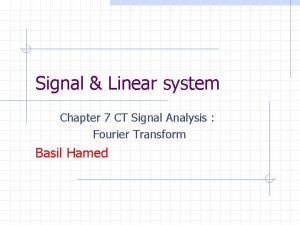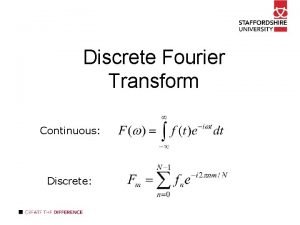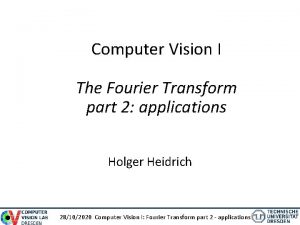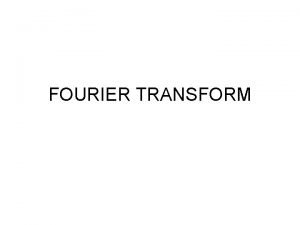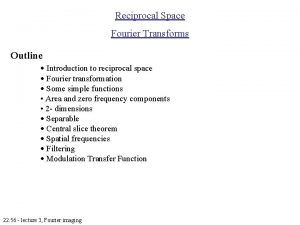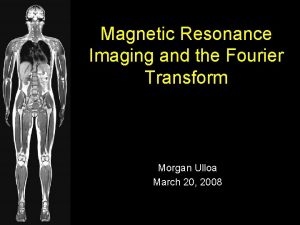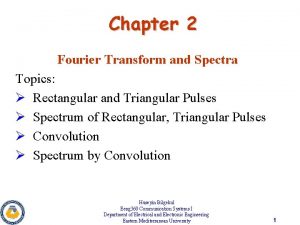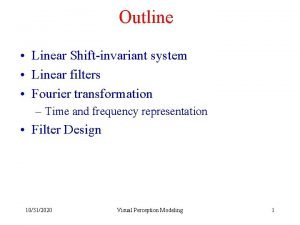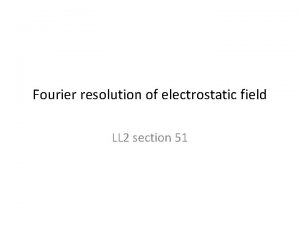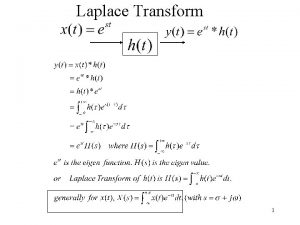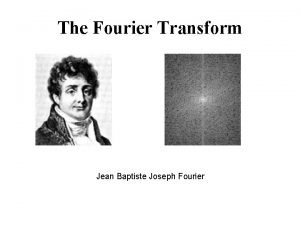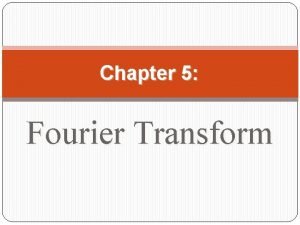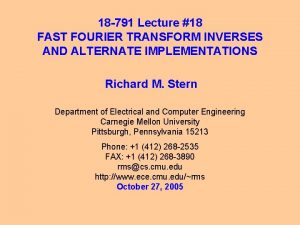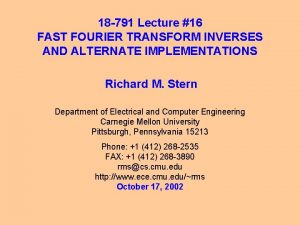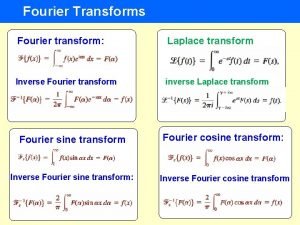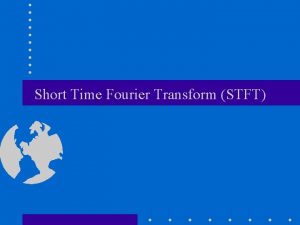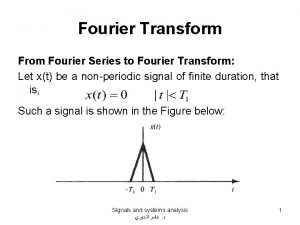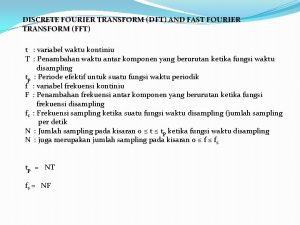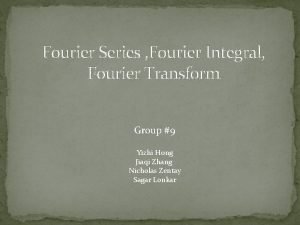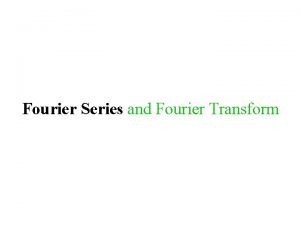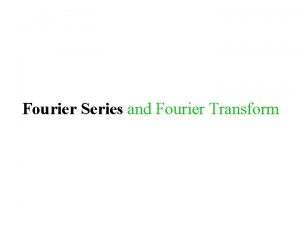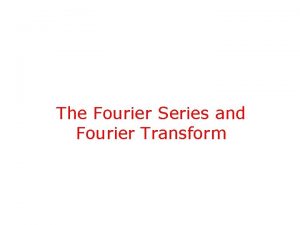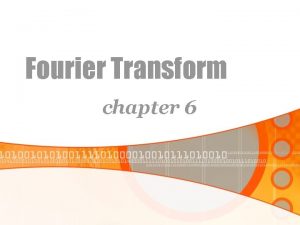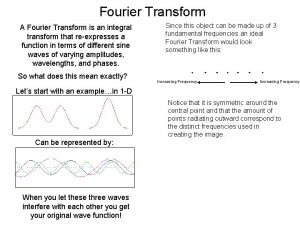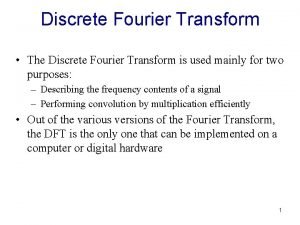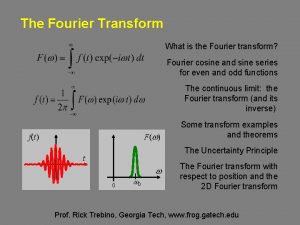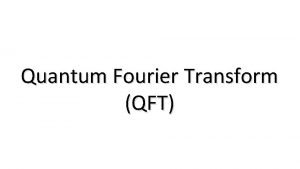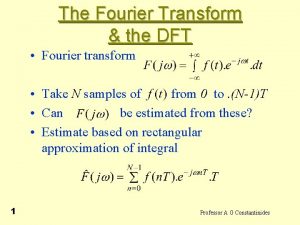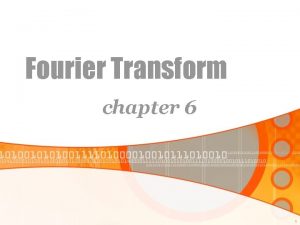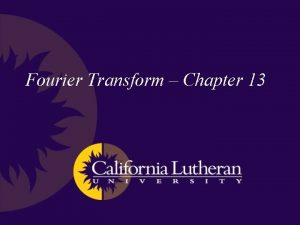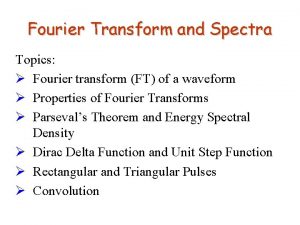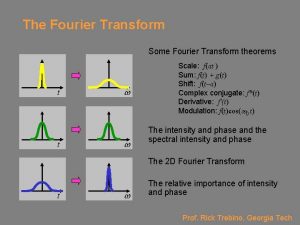18 791 Lecture 18 FAST FOURIER TRANSFORM INVERSES



























- Slides: 27

18 -791 Lecture #18 FAST FOURIER TRANSFORM INVERSES AND ALTERNATE IMPLEMENTATIONS Richard M. Stern Department of Electrical and Computer Engineering Carnegie Mellon University Pittsburgh, Pennsylvania 15213 Phone: +1 (412) 268 -2535 FAX: +1 (412) 268 -3890 rms@cs. cmu. edu http: //www. ece. cmu. edu/~rms October 27, 2005

Introduction n In our lecture last Tuesday we described and discussed the basic decimation-in-time Cooley-Tuckey fast Fourier transform algorithm for DFT sizes that are integer powers of 2 (radix 2) n Today we will discuss some variations and extensions of the basic FFT algorithm: – Alternate forms of the FFT structure – Computation of the inverse DFT – The decimation-in-frequency FFT algorithm – FFT structures for DFT sizes that are not an integer power of 2 Carnegie Mellon Slide 2 ECE Department

Alternate FFT structures n We developed the basic decimation-in-time (DIT) FFT structure in the last lecture, but other forms are possible simply by rearranging the branches of the signal flowgraph n Consider the rearranged signal flow diagrams on the following panels …. . Carnegie Mellon Slide 3 ECE Department

Alternate DIT FFT structures (continued) n DIT structure with input bit-reversed, output natural (OSB 9. 10): Carnegie Mellon Slide 4 ECE Department

Alternate DIT FFT structures (continued) n DIT structure with input natural, output bit-reversed (OSB 9. 14): Carnegie Mellon Slide 5 ECE Department

Alternate DIT FFT structures (continued) n DIT structure with both input and output natural (OSB 9. 15): Carnegie Mellon Slide 6 ECE Department

Alternate DIT FFT structures (continued) n DIT structure with same structure for each stage (OSB 9. 16): Carnegie Mellon Slide 7 ECE Department

Comments on alternate FFT structures n A method to avoid bit-reversal in filtering operations is: – Compute forward transform using natural input, bit-reversed output (as in OSB 9. 10) – Multiply DFT coefficients of input and filter response (both in bitreversed order) – Compute inverse transform of product using bit-reversed input and natural output (as in OSB 9/14) n Latter two topologies (as in OSB 9. 15 and 9. 16) are now rarely used Carnegie Mellon Slide 8 ECE Department

Using FFTs for inverse DFTs n We’ve always been talking about forward DFTs in our discussion about FFTs …. what about the inverse FFT? n One way to modify FFT algorithm for the inverse DFT computation is: – Replace by wherever it appears – Multiply final output by n This method has the disadvantage that it requires modifying the internal code in the FFT subroutine Carnegie Mellon Slide 9 ECE Department

A better way to modify FFT code for inverse DFTs n Taking the complex conjugate of both sides of the IDFT equation and multiplying by N: n This suggests that we can modify the FFT algorithm for the inverse DFT computation by the following: – Complex conjugate the input DFT coefficients – Compute the forward FFT – Complex conjugate the output of the FFT and multiply by n This method has the advantage that the internal FFT code is undisturbed; it is widely used. Carnegie Mellon Slide 10 ECE Department

The decimation-in-frequency (DIF) FFT algorithm n Introduction: Decimation in frequency is an alternate way of developing the FFT algorithm n It is different from decimation in time in its development, although it leads to a very similar structure Carnegie Mellon Slide 11 ECE Department

The decimation in frequency FFT (continued) n Consider the original DFT equation …. n Separate the first half and the second half of time samples: n Note that these are not N/2 -point DFTs Carnegie Mellon Slide 12 ECE Department

Continuing with decimation in frequency. . . n For k even, let n For k odd, let n These expressions are the N/2 -point DFTs of Carnegie Mellon Slide 13 ECE Department

These equations describe the following structure: Carnegie Mellon Slide 14 ECE Department

Continuing by decomposing the odd and even output points we obtain … Carnegie Mellon Slide 15 ECE Department

… and replacing the N/4 -point DFTs by butterflys we obtain Carnegie Mellon Slide 16 ECE Department

The DIF FFT is the transpose of the DIT FFT n To obtain flowgraph transposes: – Reverse direction of flowgraph arrows – Interchange input(s) and output(s) n DIT butterfly: DIF butterfly: n Comment: – We will revisit transposed forms again in our discussion of filter implementation Carnegie Mellon Slide 17 ECE Department

The DIF FFT is the transpose of the DIT FFT n Comparing DIT and DIF structures: DIT FFT structure: DIF FFT structure: n Alternate forms for DIF FFTs are similar to those of DIT FFTs Carnegie Mellon Slide 18 ECE Department

Alternate DIF FFT structures n DIF structure with input natural, output bit-reversed (OSB 9. 20): Carnegie Mellon Slide 19 ECE Department

Alternate DIF FFT structures (continued) n DIF structure with input bit-reversed, output natural (OSB 9. 22): Carnegie Mellon Slide 20 ECE Department

Alternate DIF FFT structures (continued) n DIF structure with both input and output natural (OSB 9. 23): Carnegie Mellon Slide 21 ECE Department

Alternate DIF FFT structures (continued) n DIF structure with same structure for each stage (OSB 9. 24): Carnegie Mellon Slide 22 ECE Department

FFT structures for other DFT sizes n Can we do anything when the DFT size N is not an integer power of 2 (the non-radix 2 case)? n Yes! Consider a value of N that is not a power of 2, but that still is highly factorable … n Then let Carnegie Mellon Slide 23 ECE Department

Non-radix 2 FFTs (continued) n An arbitrary term of the sum on the previous panel is n This is, of course, a DFT of size Carnegie Mellon Slide 24 of points spaced by ECE Department

Non-radix 2 FFTs (continued) n In general, for the first decomposition we use n Comments: – This procedure can be repeated for subsequent factors of N – The amount of computational savings depends on the extent to which N is “composite”, able to be factored into small integers – Generally the smallest factors possible used, with the exception of some use of radix-4 and radix-8 FFTs Carnegie Mellon Slide 25 ECE Department

An example …. The 6 -point DIT FFT n P 1 = 2; P 2 = 3; Carnegie Mellon Slide 26 ECE Department

Summary n This morning we considered a number of alternative ways of computing the FFT: – Alternate implementation structures – The decimation-in-frequency structure – FFTs for sizes that are non-integer powers of 2 – Using standard FFT structures for inverse FFTs n Starting on Tuesday we will begin to discuss digital filter implementation structures Carnegie Mellon Slide 27 ECE Department
 R fft
R fft Fast fourier transform in r
Fast fourier transform in r Fast fourier transform java
Fast fourier transform java Fast fourier transform (fft)
Fast fourier transform (fft) Fast fourier transform
Fast fourier transform 791-179-455
791-179-455 A word 791
A word 791 Rfc791
Rfc791 Discrete fourier transform formula
Discrete fourier transform formula Transformation jpeg
Transformation jpeg Rayleigh energy theorem
Rayleigh energy theorem Series de fourier
Series de fourier Amplitude5
Amplitude5 Fourier transform formula table
Fourier transform formula table Fourier transform
Fourier transform Fourier transform of impulse signal
Fourier transform of impulse signal Duality of fourier transform
Duality of fourier transform Discrete fourier transform
Discrete fourier transform Fourier transform in computer vision
Fourier transform in computer vision 2 pi f t
2 pi f t Top hat function fourier transform
Top hat function fourier transform Fourier transform mri
Fourier transform mri Fourier transform of shifted rectangular pulse
Fourier transform of shifted rectangular pulse Sinc function fourier transform
Sinc function fourier transform Fourier transform formula
Fourier transform formula Relation between laplace and fourier transform
Relation between laplace and fourier transform Fourier cosine transform of f(x)=1
Fourier cosine transform of f(x)=1 Fourier transform is defined for
Fourier transform is defined for
